Heating in a wooden house: a comparative overview of suitable systems for a wooden house
More recently, heating in a wooden house was organized on the basis of a brick stove. That it was the main source of heat and was almost the main place inside the building.
Today, everything has changed a lot. Thanks to the active development of technology, any owner of a wooden house will be able to implement a heating system scheme that will satisfy all his needs. The main thing is to know what to choose and what nuances to pay attention to.
The content of the article:
Varieties of heating systems
First of all, the house can be heated using an autonomous construction with forced or gravitational (natural) coolant circulation. Each of these methods has its advantages and disadvantages. In addition, there are situations when it is better to use one or another variety.
Advantages and disadvantages of natural circulation
Gravity pumping is entirely based on the laws of physics. More specifically, the heat carrier moves through the pipeline due to the weight difference between chilled and heated water.
Hot liquid has a much larger volume, but much less mass. Accordingly, it rises upward in the riser, moves further along pipes that are laid downhill, and is pumped into heating radiators, where it is cooled.

The list of advantages of such a solution should include ease of installation. The natural circulation system lasts much longer and is stable. At the same time, the absence of a pump allows you to get rid of excess noise and ensure independence from the availability of electricity.
As for the shortcomings, this kind of solution can only be used when heating a small house. In addition, the system needs to lay large diameter pipes, which significantly increases the cost of organizing a home heating system.

Distinctive features of pumping systems
To make the water move faster through the pipes, it crashes into the heating system circulation pump. With it, you can move the media with virtually no loss of temperature. As a result, the wooden building warms up much faster, which saves a considerable part of the fuel.
The main advantage of forced circulation is that the area of the heated house can be almost unlimited. In this case, the owner is given the opportunity to control the amount of heat and the speed of the pump. The disadvantages of this solution are the dependence of the system on the availability of electricity and high noise equipment.

Types of thermal carriers
To transfer heat from the generator to the heated room, water is most often used, which has been heated to a certain temperature and circulates through the pipeline.
Today it is the most affordable and simplest solution. Correctly calculating the number of radiators and boiler power, you can organize a high-performance system that does not need any special care.
In addition to water heating, in a private wooden house it is used:
Also, a combined option is often used. A well-designed scheme provides the opportunity, without spending a lot of money, to build a system that will completely warm the house in a matter of hours.
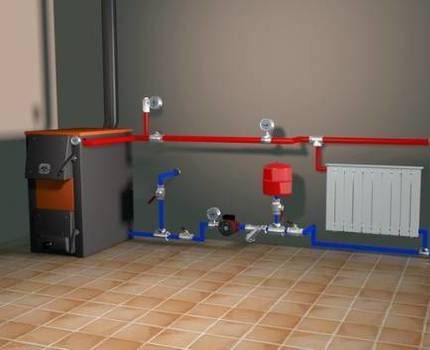
Criteria for choosing a heat generator
There is simply a huge selection on the market - domestic and foreign manufacturers offer a wide variety of models. From this assortment, a buyer with any income level will be able to choose something for himself.
In order not to miscalculate with the purchase of a boiler, you need to check which type of fuel is most available in the region. It is also important to correctly calculate the power of the equipment.
Advantages of gas units
The overwhelming majority of owners of wooden houses stop on gas equipment.
The popularity of wall and floor gas boilers due to the fact that such fuel in many countries is one of the cheapest. In addition, it can be used to organize a fully autonomous and maintenance-free heating system.
The list of advantages of gas boilers must be supplemented:
- High efficiency. Even a low-power apparatus generates a greater amount of heat than its counterparts operating on other types of fuel.
- Simplicity of operation. No need to puzzle over where the fuel will be stored. At the same time, using such equipment is easy - just set it up only once.
- Longevity. A high-quality gas unit will last at least 15 years.
The main disadvantage is the need to obtain special permission for its installation.All other cons are completely leveled by virtues.

Diesel component in the system
Diesel-powered equipment has been gaining in popularity over the past few years. Primarily, liquid fuel boilers cheap to maintain and easy to install.
In this case, it is not necessary to organize a complex design of the chimney - many models run on light stove fuel. The only thing required is to arrange the output of the pipe in the form of a sandwich. It has a special turbine that pushes air.
If it was decided to install a diesel boiler, then you need to understand that such a heating method will be expensive. After all, the efficiency of this equipment varies from 75 to 85%, which is a rather low indicator.
Also, a diesel engine needs constant monitoring. If left for at least a week, this will lead to problems. Indeed, due to the low quality of fuel, equipment may stop. As a result, the water in the pipes will freeze and tear them.
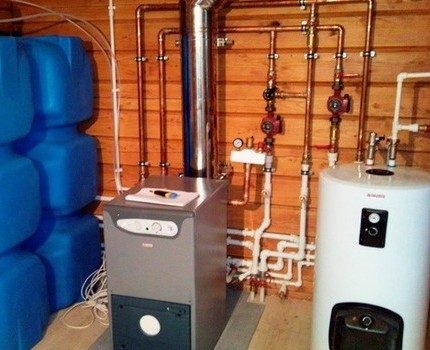
Solid fuel boiler
This type of equipment is as popular as gas. Great demand is due to the efficiency and environmental friendliness of a solid fuel boiler. After all, such a device is the cheapest device to operate. At the same time, it burns renewable fuels and is highly energy efficient.
An impressive selection on the market solid fuel boilers. Savings in this matter are not always justified - deciding to buy the cheapest model, you need to be prepared for the appearance of soot, soot and put up with the need for frequent cleaning.
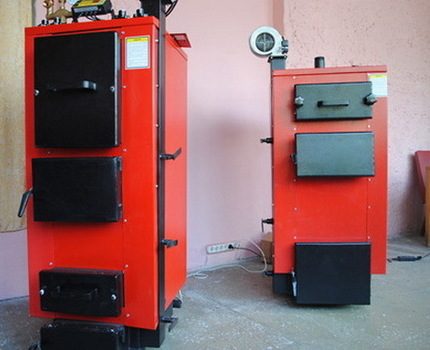
Electric heat generator
Equipment that uses current in its work is the only solution for those regions where centralized communication systems are not laid. Most often it is used as an additional option.
Today, manufacturers offer a wide range of electric boilers. On the market are models with a capacity of 6 to 30 kW. Such a wide range of performance allows you to order a device for a wooden house of any size.
Advantages of equipment:
- small dimensions;
- operational safety;
- full autonomy;
- cheapness;
- Efficiency approaching 100%.
But keep in mind that electricity is the most expensive energy source. Therefore, even despite the low cost of the unit, the operation of such a system will be expensive.
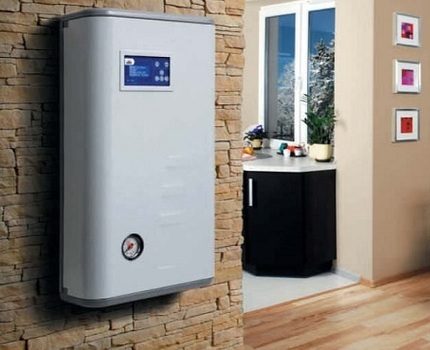
Power calculation rules
To determine the optimal boiler performance, it is not necessary to seek the help of a specialist. To do this, you only need to determine the amount of heat loss. Knowing this value, it must be multiplied by the area of the house and the resulting number will be the required power.
If the building is not insulated in any way, then 130 to 200 watts will be required to heat one square meter. For buildings with old windows and a facade that is covered with cold-resistant material, the optimum value is 90-120 W / m2.
As for houses with good thermal insulation of attic and basement floors, plastic double-glazed windows, insulated doorways, properly arranged air exchange, then 50-80 W / m will be enough to heat them2.
Subtleties of the selection of radiators
Radiators are one of the most important components of the system. After all, they spread heat throughout the living area. Therefore, their choice should be taken with full responsibility, and not buy the first product that comes across.
Batteries are divided into categories depending on the design and the material from which they are made.Since a wide assortment can lead an unprepared buyer to a standstill, before going to the store you need to understand the advantages and disadvantages of each type.
Aesthetics of aluminum structures
Such products appeared in Italy more than 35 years ago. Since its invention aluminum radiators heating immediately became popular and won the recognition of professionals.
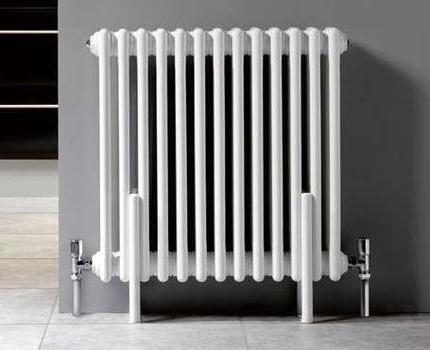
And this is not at all surprising, because these designs are lightweight, high heat dissipation, as well as an attractive design. But they are poorly resistant to corrosion and prone to airing.
Aluminum batteries can be cast or extruded. The first type is a monolithic structure, and the second is a blank formed by a press, from which finished products are subsequently cut.
Cast constructions are considered more reliable and durable. In other parameters, their analogue is not inferior to them at all.
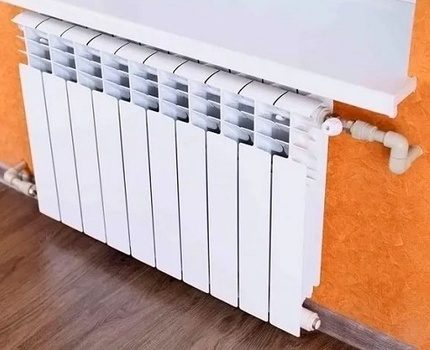
Panel Steel Radiators
Steel is an excellent conductor of heat. Therefore, batteries made from it are considered the most efficient and are recommended for installation by all specialists. In addition, they are a monolithic design, which greatly simplifies installation.
Subject to use steel radiators in the house or in the country with an autonomous heating system they have no shortcomings. If you follow all the recommendations, then the service life can reach 30 years.
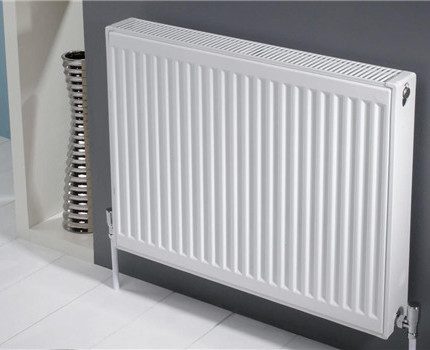
Good old cast iron
For the first time, cast-iron radiators began to be used more than a century ago. But even today they have not lost their relevance and are actively installed in heating systems.
The reason for this is the unpretentiousness of care and simply a huge service life - cast iron faithfully will last about 50 years. At the same time, it retains heat well. The products heat up for a long time, but after turning off the heating, they will heat the room for a long time.
With all its advantages cast iron appliances have only one insignificant minus - this is a lot of weight. So, the weight of one section can reach 6 kg, and the weight of the entire battery is 36 kg.
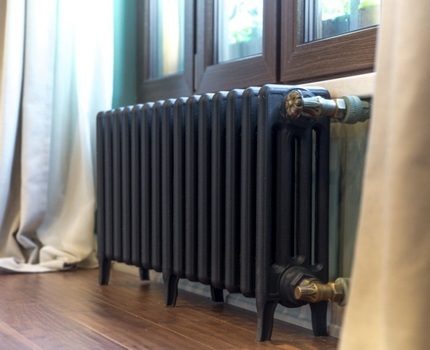
Tubular steel radiators
Tubular batteries, as a rule, are classified as products of the highest price segment. They fully comply with all quality standards and have a number of advantages over their peers.
First of all, such designs can easily withstand sudden changes in pressure, and in the event of a heat outage, the battery will not be airy.
Also, tubular radiators have a smooth surface both outside and inside. Thanks to this, they differ in attractive appearance, due to which they harmoniously fit into any interior.
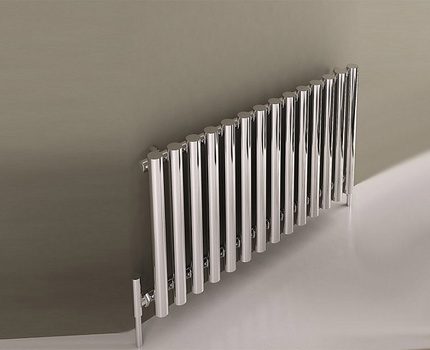
Modern bimetal designs
This kind of battery is made of an alloy of aluminum and steel. These metals have completely different characteristics, and as a result of their connection, a material with excellent performance is obtained.
More specifically, these radiators show a high thermal conductivity and can easily withstand water shocks. Subject to quality assembly bimetallic products serve about 50 years.But they are quite expensive.
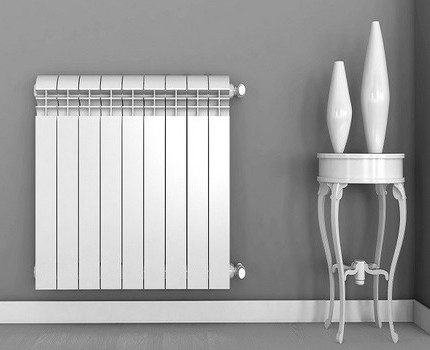
Built-in floor convectors
This heating device is a tube of copper and aluminum, through which the heat carrier moves. Main advantage floor convectors - This is an opportunity to build them directly into the floor.
In this case, the structure does not occupy precious residential square meters, but at the same time heats the building well. The only thing that comes out is a decorative grille or panel.
If installation is incorrect, drafts may form inside the room. In addition, you need to carefully monitor the cleanliness of the heating element - air flows tolerate dust well.
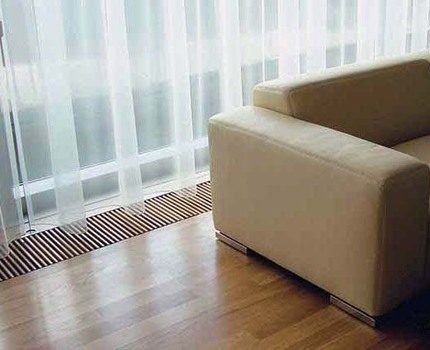
Heating pipe
The main task of the pipes is to transfer the heat carrier from the boiler to the radiators. There are many types of them - they are divided into categories depending on the material.
Pipelines are:
- polymer;
- steel;
- copper.
The latter variety is resistant to high temperatures and high pressure. Currently, copper pipes are the most reliable and safe. Thanks to this, they can be hidden in the wall. But they are quite expensive.
Now heating pipelines are most often assembled from metal-plastic or polypropylene products. They are characterized by ease of installation and resistance to corrosion. Elements are connected to each other by soldering. Their disadvantage is the low hydraulic resistance.
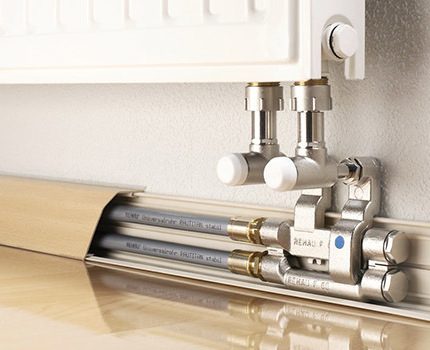
Drawing up a heating circuit
Since water is mainly used as a heat carrier, the schemes discussed below will be based on this factor. The essence of this kind of heating system for a wooden house is that the liquid is heated in the boiler and through the pipes it enters the radiators, where it is cooled. Then the water returns to the heat source.
Single pipe installation
The choice of the scheme largely depends on whether a system is used with gravitational or forced pumping of the coolant. In addition, when designing a project, you need to consider the number of circuits.

The advantage of creating a single heating circuit is its ease of installation. If you stick to the scheme, you can quickly cope with the work and not involve a master.
The one-pipe system saves plumbing fixtures. And in order to maximally equalize the temperature in the entire circuit, it is necessary to increase the number of radiator sections that are connected at the end. To speed up the water flow, it is recommended to install a pump.
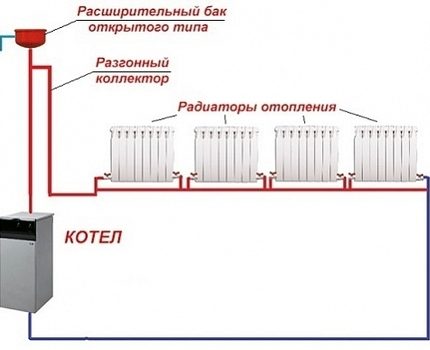
Subtleties of organizing two-pipe heating
The system with two circuits allows maintaining the same temperature in all radiators, which will favorably affect the heating efficiency. The disadvantage of this solution is the high consumption of materials.
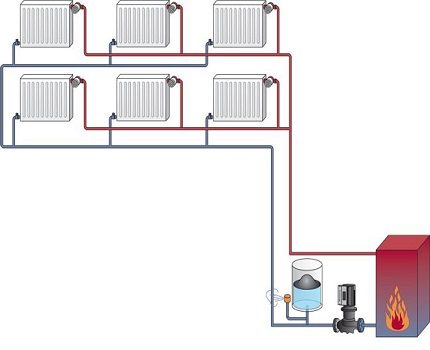
When implementing a two-pipe project, each radiator must be equipped with shut-off valves. Such elements will allow you to adjust the temperature in each room.
If the boiler will be installed in the basement, the best choice is a system with a lower wiring (the diagram is presented below). This solution is ideal for wooden houses, where a gas boiler is used as a heat generator.
Conclusions and useful video on the topic
Video # 1. Organization of a simple inexpensive boiler room:
Video # 2. Heating of a wooden house with an area of 120 m2:
Video # 3. The nuances of laying the pipeline:
The heating system is the heart of any home. Therefore, the owner of the building is faced with the task of correctly designing and correctly installing such an important element. If you make a little effort and take into account all the tips given above, then installing the heating system will not cause any difficulties during connection and operation problems.
Tell us about how you built the heating circuit in your own wooden cottage or in a house of permanent residence. Share useful information that may be useful to site visitors. Please write comments, post photos, ask questions in the block below.

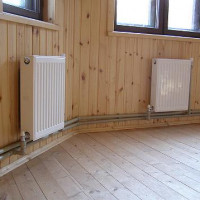 Steam heating in a private house and in a country house based on a stove or boiler
Steam heating in a private house and in a country house based on a stove or boiler 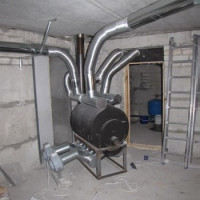 How to arrange air heating of a country house: rules and schemes of construction
How to arrange air heating of a country house: rules and schemes of construction 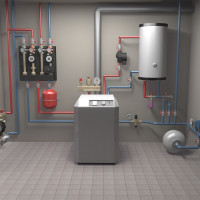 Water heating in a private house: rules, norms and organization options
Water heating in a private house: rules, norms and organization options  Two-pipe heating system of a private house: device diagrams + overview of the advantages
Two-pipe heating system of a private house: device diagrams + overview of the advantages  Heating scheme from a gas boiler in a two-story house: a review and comparison of the best heating schemes
Heating scheme from a gas boiler in a two-story house: a review and comparison of the best heating schemes 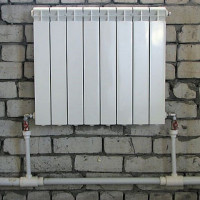 One-pipe heating system of a private house: schemes + an overview of the advantages and disadvantages
One-pipe heating system of a private house: schemes + an overview of the advantages and disadvantages  How much does it cost to connect gas to a private house: the price of organizing gas supply
How much does it cost to connect gas to a private house: the price of organizing gas supply  The best washing machines with dryer: model rating and customer tips
The best washing machines with dryer: model rating and customer tips  What is the color temperature of light and the nuances of choosing the temperature of the lamps to suit your needs
What is the color temperature of light and the nuances of choosing the temperature of the lamps to suit your needs  Replacement of a geyser in an apartment: replacement paperwork + basic norms and requirements
Replacement of a geyser in an apartment: replacement paperwork + basic norms and requirements
My family and I live in a wooden house on the second floor. Naturally, there is no water or central heating. For a long time they warmed up the apartment, having flooded the stove, then they bought ordinary fan heaters, but since they only heat the air and the floor remains cold, walking on it is not very pleasant. Too complex heating systems, in my opinion, require enormous financial costs, and also add unnecessary problems with the development of the circuit, installation and other prominent inconveniences. The best option I think is a combination of underfloor heating and conventional heaters. If the apartment is small, I think this will be enough.
In my country house (a wooden house) there is a gas floor boiler of Czech manufacture Dacon, I don’t know any problems with it. 200 square meters warms up quietly, with a margin. And it was not so expensive. Radiators are ordinary, aluminum. Of course, it would be nice to have a warm floor, but installation seems too complicated. You can still get confused at home, but perhaps not for a summer house.